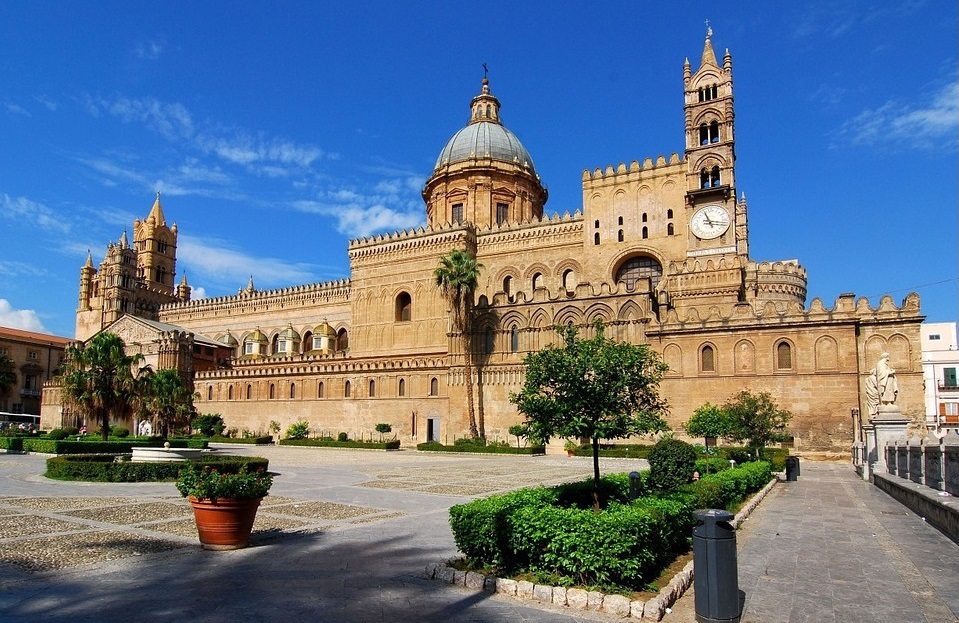Sicily is the largest Italian island, separated from the mainland by the Strait of Messina. It offers a multitude of places to visit, between nature, history and tradition. Among the peculiarities of this territory are its volcanoes, such as Etna, the largest active volcano in Europe. But also the archaeological complex of Agrigento, a treasure of humanity recognized by UNESCO, which was one of the most important cities of Magna Graecia. Sicily has many other archaeological testimonies that tell the story of the distant origins of the people of Trinacria (the ancient name of Sicily).
A great crossroads of civilizations, this island offers a fabulous and exciting cultural heritage!
Authentic 9 Day Sicily Tour
Day 1: Departure from Marseille in the early afternoon to Genoa. Dinner (free) in the city, then boarding of the boat late in the afternoon. Stay on board.
Day 2: Rest day on the boat, (Free breakfast and lunch). Arrival in Palermo late in the afternoon or early evening (timetables variable according to the seasons). Installation at the hotel, dinner and accommodation in Palermo.
Day 3: Morning dedicated to the guided city tour of Palermo: the cathedral and the Norman palace with its famous Palatine Chapel. Not far from Palermo we ascent to Montreale, a small town built around a Benedictine abbey and its 12th century cloister, made famous by its decoration of marble, paintings but also and above all by the mosaics that cover its vaults and walls. Return to Palermo for the lunch, then free afternoon in the city. Dinner and accommodation at the hotel.
Day 4: Departure from Palermo early in the morning to Segesta, an ancient Greek city, to see its Doric temple from the 5th century BC and its theatre. Then, continuation to Erice, an ancient Phoenician and then Greek city, perched at 750 m above sea level and offering a panoramic view of the city of Trapani and the Egadi Islands. Walk and tasting of local cakes made of marzipan. Lunch in Trapani, a small port sheltered town living of salt traffic. In the early afternoon, departure for Marsala, a walk through the salt marshes nature reserve, then on to Agrigento. Dinner and accommodation at the hotel.
Day 5: In the morning, guided tour of the archaeological sites and temples located in the Valley of the Temples (UNESCO heritage), then departure for Syracuse. On the way, stop in Ragusa, a city partly rebuilt after the earthquake of 1693, and then in Noto also rebuilt after the earthquake and which today offers a beautiful complex of Baroque monuments.
Day 6: Morning dedicated to a guided tour of Syracuse, once one of the most prestigious cities of Sicily and Ancient Greece: the Greek Theatre, the Latomies of Paradise, the Ear of Dionysius, the Roman Amphitheatre, the Cathedral, the source of Arethusa and the Temple of Apollo. Lunch in Catania, then free afternoon in the city. Return to Syracuse at the end of the day, dinner and overnight at the hotel.
Day 7: Departure from Syracuse early in the morning for the ascent of the volcano Etna. Possibility of optional excursion in 4×4 up to 3000m of altitude (depending on volcanic activity). Lunch on the spot, then continuation to Taormina for the visit of the Greco-Roman theatre, and afterwards free time in this charming little village considered the pearl of the Ionian coast. Dinner and accommodation at the hotel in Giardini Naxos.
Day 8: Morning departure to Messina, to see the original astronomical clock in Piazza del Duomo, and then continue to the picturesque fishing village of Cèfalu. Guided tour of the historical center, lunch and then free time. Late afternoon arrival in Palermo. Free time in the city. Dinner and boarding of the boat to Genoa. Stay on board.
Day 9: Rest day on board (Free breakfast and lunch). Arrival in Genoa late in the afternoon and continuation to Marseilles. (Stop along the way for a packed lunch). Arrival in Marseilles late in the evening.

Palermo
Palermo is a city in southern Italy, the capital of the autonomous region of Sicily. The city is known for its history, culture, architecture and gastronomy. Among the tourist attractions you will find the Cathedral and the Palazzo dei Normanni with its famous Palatine Chapel.

Agrigento
Agrigento, the valley of the Greek temples in Italy. Considered one of the main cities of the Golden Age of Ancient Greece. Today thousands of tourists discover this impressive site and its museum which exhibits pieces from different historical periods.

Siracusa
Siracusa is a historical city located on the island of Sicily, capital of the Italian province of Siracusa. The city is remarkable for its rich Greco-Roman history. With an archaeological area to discover and its own museum, this city full of history awaits you.

Etna
Mount Etna is an active stratovolcano located on the east coast of Sicily, in the metropolitan city of Catania. The Volcano took its name from the Greek word αἴθω (aithō) which means “I burn”. Etna is one of the main attractions of Sicily, with thousands of visitors every year.

Taormina
Taormina is a municipality of the city of Messina, on the east coast of the island of Sicily. Taormina has a long history with tourism, being a tourist destination since the 19th century. Its most notable attractions include several Greek Theatres.

Messina
Messina is the third largest city on the island of Sicily and the 13th largest city in Italy. The Regional Museum, the Cathedral and the Piazza del Duomo these are just some of the attractions you can visit in Messina.

